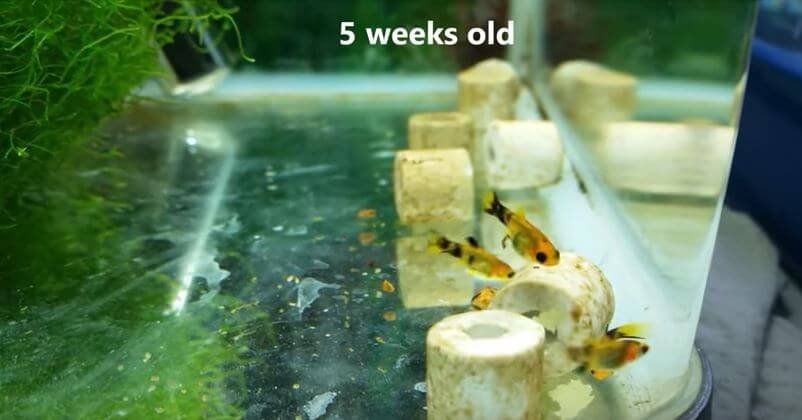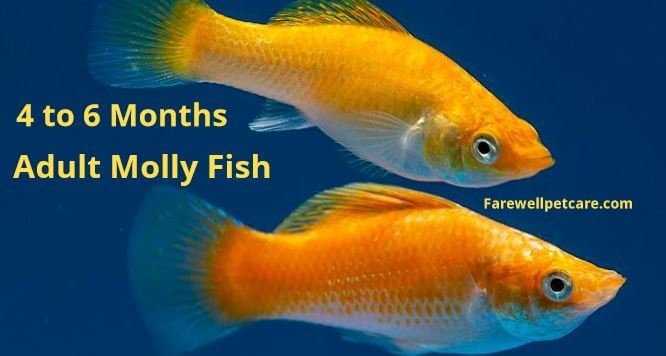Molly fish have become a commercially acceptable ornamental fish among new aquarium enthusiasts. They are easy to groom and breed. This ultimate guide reveals the molly fry growth stages to help you track your little fish’s growth performance and stages.
Molly fry growth stages begin from the time fries are hatched. Then the fry transitions into juveniles, which grow for about 30-60 days. Later at 2-4 months, they become fingerlings; at 4-6 months, they develop into fully grown adult mollies.
In this guide, you’ll learn the four molly fry growth stages. You’ll also know the best practices to undertake to ensure your mollies are transitioning smoothly from one stage of life to another. Stay tuned!
Molly Fry Growth Stages: The Molly Fry Growth Chart
The following is a molly fry growth chart to help you track your pet’s progress:
| Growth Stage | Number of Days/Months | Description |
| Fry Stage | 1-30 days | The first stage of life that’s delicate and vulnerable |
| Juvenile Stage | 30-60 days | Reproductive organs (gonopodium) begin appearing. You can now distinguish between a male and female molly fish |
| Fingerling Stage | 2-4 months | Molly is the size of a small finger. It can run from predators on its own |
| Adult Stage | 4-6 months | Fully grown molly fish, 3 to 5 inches (7.62 to 12.7 cm) long |
1. Fry Stage

The fry stage begins the life cycle of a molly fish. Fry is a tiny molly fish, about half an inch (1.2 cm) in size. They have transparent bodies, and you can see organs toning dull colors.
However, the organ color intensifies after two weeks. By day 30, you can even see a slightly colored body.
Being the most delicate stage of life, fry are vulnerable and tend to hide most of the time. Otherwise, they will be preyed on by adult mollies and other fish. This is why you must remove the adult mollies from the tank after breeding to allow the fry to grow without threats.
Usually, the fry stage lasts one month, from day one to day thirty.
Find Out: How Many Mollies Should Be Kept Together?
2. Juvenile Stage

The juvenile stage begins after four weeks and lasts about two months. The main highlight of the juvenile stage is the visible reproductive organs or gonopodium, which is vital in differentiating between male and female molly fish.
Moreover, the fish develops more color, although it’s still dull. The transparency presented in the fry stage begins disappearing. The body becomes dull-colored within one month.
Juveniles are more independent and can now sense and hide from danger. Rapid growth occurs at the same time.
3. Fingerling Stage
In the fingerling stage, mollies attain the size of a small finger—hence the name fingerlings.
Depending on the breed, fingerlings can be between 2 to 4 inches (5.08 to 10.16 cm).
The fingerlings are big enough to live with other adult fish without worrying about being swallowed. However, they can still face bullying threats by adult mollies.
It’s worth noting that this is the sexual maturity stage. Therefore, it’s essential to separate males from females if you’re not ready for breeding. Otherwise, they’ll breed and cause inconvenience.
4. Adult Stage

The adult stage starts at 4-6 months when Molly fry becomes fully grown fish. The fish is about 3 to 5 inches (7.62 to 12.7 cm) long. However, molly sizes vary due to breed differences.
At this stage, you can transfer the fish to the main tank for the adult diet. You shouldn’t expect much growth at this stage since the maximum length has probably been reached.
Mollies become more active especially when looking for sexual partners. In general, they’re peaceful and enjoy staying in groups. Consequently, keep at least three or four mollies in your aquarium to enhance the social aspect of their lifestyle.
How Many Molly Fry Will Survive?
According to the International Journal of Pure and Applied Zoology, about 50 percent of molly fry will survive. The other fifty percent will succumb to different dynamics, including predation, unconducive water parameters, and poor care by the aquarists.
Nevertheless, some aquarists survive all their mollies by providing optimal care and management.
Basically, the survival rate of your molly fry depends on tank conditions. Favorable tank conditions increase the survival rate of mollies.
Here are the things you should do to ensure a high molly fry survival rate:
1. Remove the Parents Once Fry Arrive
It’s essential to remove the parents and take them back to the main tank just after hatching the fry.
Separating fry from their parents eliminates the risk of predation, enhancing the survival rate.
It’s easier to achieve high survival rates by doing this simple practice.
However, some aquarists don’t intend to raise many fingerlings. Therefore, they let the parents feed on fry and remove them from the breeding tank once they feel a manageable number has remained.
2. Feed Molly Fry a High-Quality Diet
A high-protein diet is vital for the survival of many fry.
According to the International Journal for Research Trends and Innovation, molly fry fed with homemade protein feed grows faster, gains maximum weight, and experiences low mortality rates.
You can attribute such results to the high protein content in homemade protein feed. Generally, fish require plenty of amino acids—2-4 times more dietary protein for accelerated growth and survival.
3. Maintain High-Quality Water in the Tank
The water quality in the breeding tank should be flawless. You must maintain the correct water chemistry to prevent harmful gases like ammonia from poisoning your fry.
Here are the crucial water parameters to maintain:
- The temperature should be maintained between 75 to 80℉ (23.89 to 26.67℃)
- Maintain a pH of 7.5-8.5
- Nitrates should be less than 30 ppm
- Zero ammonia in the water
- Maintain general hardness or GH at 12-25 dGH
- Maintain KH OR carbonate hardness at 10-25 dKH
Your fry’s survival rate will be high if you keep these parameters in check. This is precisely what you want for a conducive ecosystem in the breeding tank.
Your fry will die in large numbers due to an unfavorable environment if you don’t balance the water parameters.
4. Use a Filtration System
You should know the importance of high-quality filters in aquariums. Filters help remove impurities and leave the water clean and well-oxygenated. This automatically boosts the survival rate of your fish.
It’s advisable to install a high-quality filter for the best results. The filter should not suck in your fry since they’re still so small.
That said, consider contacting an expert aquarist or breeder for the best fry filter.
How Long Do Baby Mollies Grow?
Baby mollies grow up to 3 to 5 inches (7.62 to 12.7 cm) long to make adult mollies. They take about 3-4 months to attain this full size. You can accelerate the growth by feeding your baby mollies properly with high-nutrition feed like live brine shrimp and vinegar eels.
Females reach sexual maturity earlier, taking only four to six months. On the other hand, males can take up to one year to be sexually mature, although some will do so at the same time as females.
Remember, growth happens fast or slowly due to several reasons. For instance, growth is fast if you provide your fry with top-quality, high-protein food. Expect a slump in growth and delayed maturity if you give them low protein feed.
Moreover, the aspect of water quality can improve or reduce your molly fry’s growth rate. The fry will have more health problems if the water has a lot of impurities.
What Do You Feed Baby Molly Fry?
You should feed baby molly fry a nutritious, high-protein diet that should contain the following:
- Baby brine shrimp
- High-quality powdered flakes
- Pellets
- Worms
- Liquid fry
- Insuforia
You should provide the feeds in small quantities to avoid overfeeding.
Baby mollies love munching something at least every other time, but you should control this by giving measured amounts of food after a defined time interval, usually two hours.
The diet can remain the same from when mollies are babies until adulthood. The only thing that should change is the daily amount—increase the amount as the fish grows into adulthood.
Remember to clean any excess feed your fry leaves suspended or settling on the floor. Otherwise, you run the risk of ammonia in the tank when the food decomposes. You can also include algae in the diet to help with skin pigmentation. However, remember you can’t rely on baby mollies to wipe clean an algae infestation in the breeding tank. Therefore, you must maintain it yourself.
Final Thoughts
Understanding molly fry growth stages is essential for providing the best care.
From hatching and the delicate fry stage to the striking transformation of adulthood, each stage provides a unique glimpse into the mesmerizing world of molly fry growth.
By understanding the distinctive characteristics of each stage, you’ll provide optimum care for their healthy development.
As you embark on this fascinating adventure, ask yourself, “Are you ready to witness the inspiring process of molly fry growth? The answer lies within you.

